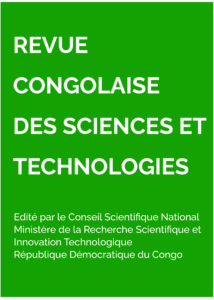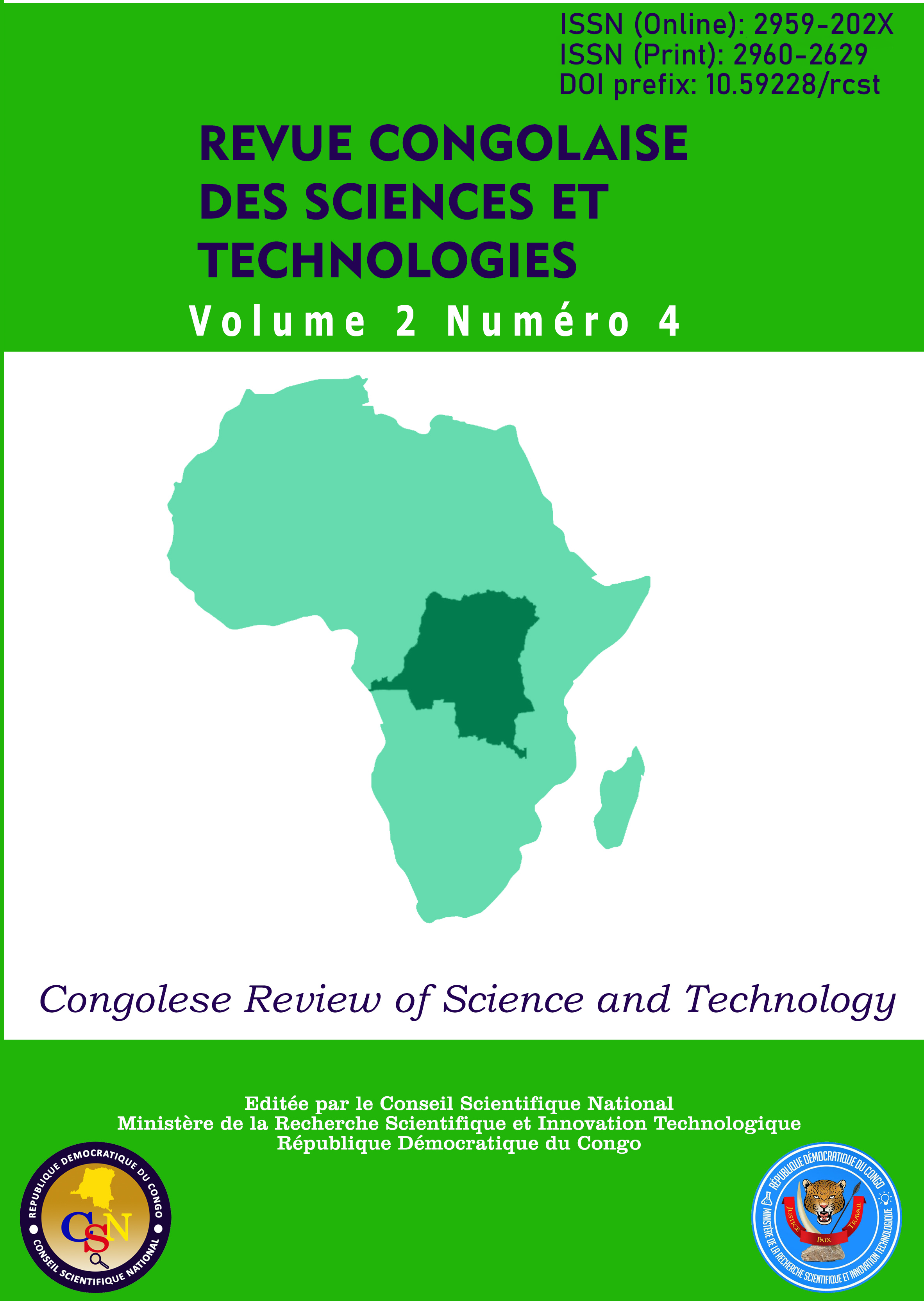Review of Medicinal Plants of the Uvariodendron Genus (Annonaceae) and the Potential for Their Integration into the Agribusiness Strategy in the Democratic Republic of the Congo
Main Article Content
Abstract
Context: The Uvariodendron genus comprises wild plants with multiple therapeutic uses, the valorization of which could
contribute to improving the management of several diseases and their integration into the national agribusiness strategy.
Objective: This study aims to provide an overview of current knowledge about this genus in order to guide future research. Methodology: A bibliographic search of articles related to Uvariodendron was conducted in various electronic databases
(Science Direct, PubMed, Web of Science, Scopus, Google Scholar, SciELO, etc.), using keywords such as Uvariodendron,
phytochemistry, pharmacology, and toxicology. Results and Discussion: The available literature on plants of the
Uvariodendron genus indicates that they contain flavonoids, tannins, quinones, saponins, alkaloids, steroids, terpenoids,
anthocyanins, etc. These plants possess anticancer, antioxidant, anti-inflammatory, antimalarial, antimicrobial, urotonic, antisickle cell, and other properties. Toxicological studies have shown that U. anisatum (originating from Kenya) is toxic in rats.
However, U. molundense (originating from the DRC) is not cytotoxic, indicating a certain degree of safety. Conclusion and
Perspectives: The results of this study demonstrate that the Uvariodendron genus could be used for various therapeutic
applications. However, clinical studies are necessary to rigorously establish their effectiveness and safety. Additionally, the
integration of U. molundense into the national agribusiness strategy in the DRC can contribute to the country's economic,
environmental, and social sustainability while preserving its biodiversity and medicinal traditions.
Article Details

This work is licensed under a Creative Commons Attribution-NonCommercial-ShareAlike 4.0 International License.
References
Dagallier MJ, Mbago MF, Quentin Luke
WR, Couvreur LPT (2021). Three new species
of Uvariodendron (Annonaceae) from coastal
East Africa in Kenya and Tanzania. PhytoKeys
: 107–126.
doi: 10.3897/phytokeys.174.61630.
Djolu R, Masengo A, Ngbolua KN, Mawunu M,
Iteku B, Tshilanda D, Tshilanda D, Mpiana P,
Mudogo V (2021). Ethnobotanical study and
vulnerability of Uvariodendron molundense
(Annonaceae) in Gbado-Lite city (Ubangi
ecoregion), Democratic Republic of the
Congo. Journal of Botanical Research 3(3):
-48.
Djolu RD, Ngbolua KN, Iteku JB, Masengo CA,
Tshilanda DD, Mpiana PT (2023). Profil
phytochimique, pharmaco-biologique et
cytotoxique des feuilles de Uvariodendron
molundense (Annonaceae). Revue Marocaine
des Sciences Agronomiques et Vétérinaires
(2): 224-235.
Fekam BF, Amvam ZHP, Agnaniet H, Menut C,
Bessière JM (2015). Aromatic Plants of
Tropical Central Africa. XL. Essential Oils
from Uvariodendron calophyllum R.E. Fries
Growing in Cameroon. Journal of Essential
Oil Research 17(2): 128-129. doi:
1080/10412905.2005.9698852.
Kaingu KC, Oduma AJ, Mbaria J, Kiama JS (2017).
Effects of Croton menyharthii and
Uvariodendron kirkii extracts on ovarian
corpora lutea and reproductive hormones.
Discovery Phytomedicine 4(1): 21-25.
Kanji BM, Maitho ET, Wakonyu KL, Misonge OJ
(2022). Evaluation of Uterotonic Activity,
Acute Oral Toxicity, and Phytochemical
Composition of Uvariodendron anisatum
Verdc. Root Extracts. Evidence-Based
Complementary and Alternative Medicine.
https://doi.org/10.1155/2022/7393537
Kihampa C, Mayunga H, Nkunya H, Cosam CJ,
Magesa MS (2010). Antimosquito
Phenylpropenoids from the Stem and Root
Barks of Uvariodendron pycnophyllum (Diels)
R.E.Fr. J. Appl. Sci. Environ. Manag. 14(3):
-32.
Mathouet H, Sima Obiang C, Lekongo Moungomo
CM, Bourobou Bourobou HP, Ondo JP (2019).
Antibacterial efficacy of essential oil from leaf
of Uvariodendron molundense (Annonaceae),
medicinal plant of Gabon. Int. J. Biosci.15(4) :
-39. DOI:
http://dx.doi.org/10.12692/ijb/15.4.33-39Menkem E, Fokou J, Tsague I, Chouadeu P,
Bakarnga-Via I, Kamdem M, Nya P, Fokou V,
Mofor C, Fekam B (2012). Activités
antifongiques et antioxydantes de Piptostigma
calophyllum, Uvariodendron calophyllum et
Uvariodendron molundense cultivés au
Cameroun. Journal of Biologically Active
Products from Nature 2(2):110-118.
Mongeke MM, Ngbolua KN, Bakola RD, Inkoto CL,
Elikandani PN, Mowuli CY (2018). Survey on
the plants used in Traditional medicine by
Bambenga: Pygmy from Dongo Sector
(Territory of Kungu, Province of Sud-Ubangi)
in Democratic Republic of the Congo. Revue
Marocaine des Sciences Agronomiques et
Vétérinaires 6 (4): 469-475.
Ndaba MM, Djolu DR, Masengo AC, Falanga MC,
Lengbiye ME, Inkoto LC, Gbolo ZB, Ridwan
R, Mpiana PT, Mudogo V, Ngbolua KN
(2020). Congolese Medicinal Plant
biodiversity as Source of AntiCOVID-19
Compounds: Economic goods in the light of
Comparative Advantages Theory of Ricardo.
Budapest International Research in Exact
Sciences (BirEx) Journal 2(3): 298-309. doi:
https://doi.org/10.33258/birex.v2i3.1067.
Ndaba MM, Likolo JB, Bembi B, Kangu KJ, Mbaya
KJ, Magbukudua M, Masengo AC, Bongo
NG, Muhammad R, Ngbolua KN (2021a).
COVID-19 Pandemic in Democratic Republic
of the Congo: An Opportunity for Economic
Recovery. Britain International of Exact
Sciences (BIoEx) Journal 3(2).
https://doi.org/10.33258/bioex.v3i2.434.
Ndaba MM, Mawi CF, Nyante UM, Kobe JK, Djoza
RD, Magbukudua JM, Masengo MC, Bongo
GN, Ridwan M, Ngbolua KN (2021b).
COVID-19 Pandemic: Opportunity for a True
Economic and Regional Integration of Africa.
Budapest International Research in Exact
Sciences (BirEx) Journal 3(2).
https://doi.org/10.33258/birex.v3i2.1884.
Ngbolua KN, Inkoto CL, Mongo NL, Ashande CM,
Masens YB, Mpiana PT (2019). Étude
ethnobotanique et floristique de quelques
plantes médicinales commercialisées à
Kinshasa, République Démocratique du Congo.
Revue Marocaine des Sciences Agronomiques et
Vétérinaires 7(1) : 118-128.
Ngbolua KN, Tshilanda D, Djolu R, Falanga C,
Masengo C, Tshibangu D, Iteku J, Mudogo V,
Mpiana P (2017). Effets inhibiteurs bactériens
et anti-anémie falciforme de Uvariodendron
molundense (Diels) R.E.Fr. (Annonaceae) du Menkem E, Fokou J, Tsague I, Chouadeu P,
Bakarnga-Via I, Kamdem M, Nya P, Fokou V,
Mofor C, Fekam B (2012). Activités
antifongiques et antioxydantes de Piptostigma
calophyllum, Uvariodendron calophyllum et
Uvariodendron molundense cultivés au
Cameroun. Journal of Biologically Active
Products from Nature 2(2):110-118.
Mongeke MM, Ngbolua KN, Bakola RD, Inkoto CL,
Elikandani PN, Mowuli CY (2018). Survey on
the plants used in Traditional medicine by
Bambenga: Pygmy from Dongo Sector
(Territory of Kungu, Province of Sud-Ubangi)
in Democratic Republic of the Congo. Revue
Marocaine des Sciences Agronomiques et
Vétérinaires 6 (4): 469-475.
Ndaba MM, Djolu DR, Masengo AC, Falanga MC,
Lengbiye ME, Inkoto LC, Gbolo ZB, Ridwan
R, Mpiana PT, Mudogo V, Ngbolua KN
(2020). Congolese Medicinal Plant
biodiversity as Source of AntiCOVID-19
Compounds: Economic goods in the light of
Comparative Advantages Theory of Ricardo.
Budapest International Research in Exact
Sciences (BirEx) Journal 2(3): 298-309. doi:
https://doi.org/10.33258/birex.v2i3.1067.
Ndaba MM, Likolo JB, Bembi B, Kangu KJ, Mbaya
KJ, Magbukudua M, Masengo AC, Bongo
NG, Muhammad R, Ngbolua KN (2021a).
COVID-19 Pandemic in Democratic Republic
of the Congo: An Opportunity for Economic
Recovery. Britain International of Exact
Sciences (BIoEx) Journal 3(2).
https://doi.org/10.33258/bioex.v3i2.434.
Ndaba MM, Mawi CF, Nyante UM, Kobe JK, Djoza
RD, Magbukudua JM, Masengo MC, Bongo
GN, Ridwan M, Ngbolua KN (2021b).
COVID-19 Pandemic: Opportunity for a True
Economic and Regional Integration of Africa.
Budapest International Research in Exact
Sciences (BirEx) Journal 3(2).
https://doi.org/10.33258/birex.v3i2.1884.
Ngbolua KN, Inkoto CL, Mongo NL, Ashande CM,
Masens YB, Mpiana PT (2019). Étude
ethnobotanique et floristique de quelques
plantes médicinales commercialisées à
Kinshasa, République Démocratique du Congo.
Revue Marocaine des Sciences Agronomiques et
Vétérinaires 7(1) : 118-128.
Ngbolua KN, Tshilanda D, Djolu R, Falanga C,
Masengo C, Tshibangu D, Iteku J, Mudogo V,
Mpiana P (2017). Effets inhibiteurs bactériens
et anti-anémie falciforme de Uvariodendron
molundense (Diels) R.E.Fr. (Annonaceae) du bassin de la rivière Ubangi, RD Congo.
Journal of Biosciences and Medicines 5: 71-
Noudogbessi JP, Gary-Bobo M, Adomou A, Adjalian
E, Alitonou AG, Avlessi F, Garcia M,
Sohounhloue DCK, Menut C (2014).
Comparative Chemical Study and Cytotoxic
Activity of Uvariodendron angustifolium
Essential Oils from Benin. Natural Product
Communications 9(2): 261-264.
Tajbakhsh E, Kwenti TE, Kheyri P, Nezaratizade S,
Lindsay DS, Khamesipour F (2021).
Antiplasmodial, antimalarial activities and
toxicity of African medicinal plants: a
systematic review of literature. Malaria
Journal 20(1):349.
https://doi.org/10.1186/s12936-021-03866-0.
WHO (World Health Organization). Traditional
medicine strategy 2002-2005, 2002.
http://www.who.int/medicines/library/trmtraten
g.pdf.

